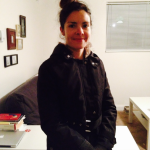
The Sorrow Proper by Lindsey Drager
a review by Jess Alexander
Dzanc Books
2015
151 pages
$14.95
At the heart of Lindsey Drager’s debut novel, The Sorrow Proper, sits the library, “an institution defined by loss,” and a kind of loom from which the other narratives unspool. “The library may close.” Thus the novel opens and the librarians (Genevieve, Mercedes, Avis) decide to get a drink. The outing turns to ritual. The novel returns, throughout its course, to the bar, where Genevieve, Avis, and Mercedes debate the value of books, collective objects, and borrowing. Meanwhile at the library, a deaf mathematician stands transfixed before a photograph, a photographer packs up his exhibition, and a family mourns the loss of their daughter, killed outside the library doors.
The Sorrow Proper begins with an epigraph from Paul Ricouer’s Time and Narrative, a text that talks of time’s mystifying properties, of time’s integrity and self-division. Time is sequence and duration. Time is change and eternity. Narrative, Ricouer says, transforms our bewilderment into a “living dialectic.” The Sorrow Proper transforms time’s artifacts into narrative: a bar of soap grows cracks, fingerprints besmirch a camera’s shutter release, a book’s pages are torn, and ink stains its margins. Yet time retains its mystifying properties, its tensions resist the mollifying promise of linearity and progress.
The photographer and mathematician will move in together, each will die, and each will mourn the other in this novel. This is the many-worlds theory, an interpretation of quantum mechanics. The many-worlds theory implies that everything that might have happened has already or will happen in a parallel universe. This also implies that somewhere in a parallel universe the loss of each presence is discretely endured. This absence is perhaps at the heart of all presence, at the heart, as Ricouer suggests in the novel’s epigraph, of temporal experience. “The absence of eternity is not simply a limit that is thought, but a lack that is felt,” writes Ricouer. “The limiting idea then becomes the sorrow proper to the negative.”
The Sorrow Proper repeatedly enacts the nagging knowledge that eventually all around us will be gone. Objects, such as spoons, photographs, and novels, are already artifacts, traces of a bygone intent, an elapsed event, a former self or friend. Shifts in tense parallel this play of presence and absence. The mathematician and photographer sit on the front porch and watch a rainstorm. Weeks later, Drager tells us, the mathematician, alone in the attic, will discover one of the photographer’s retired cameras. But now on the porch she proposes to move in with him. Presence enfolds the inevitable. The novel is non-linear and thus their shared history begins and splints, almost simultaneously, into respective mourning rituals.
The mathematician only drinks champagne and forgets the most basic calculations. The photographer takes only the elevator and waits to take it alone. The mathematician finds herself parked in strange driveways. The photographer spends his evenings filling and emptying the tub. The mathematician performs the times tables in the bath, “rests her full glass on the tub’s lip, is careful not to touch where he last set his bar of soap. “ Time, in this novel, does not iron out. It fractures instead and, maybe, devours itself.
